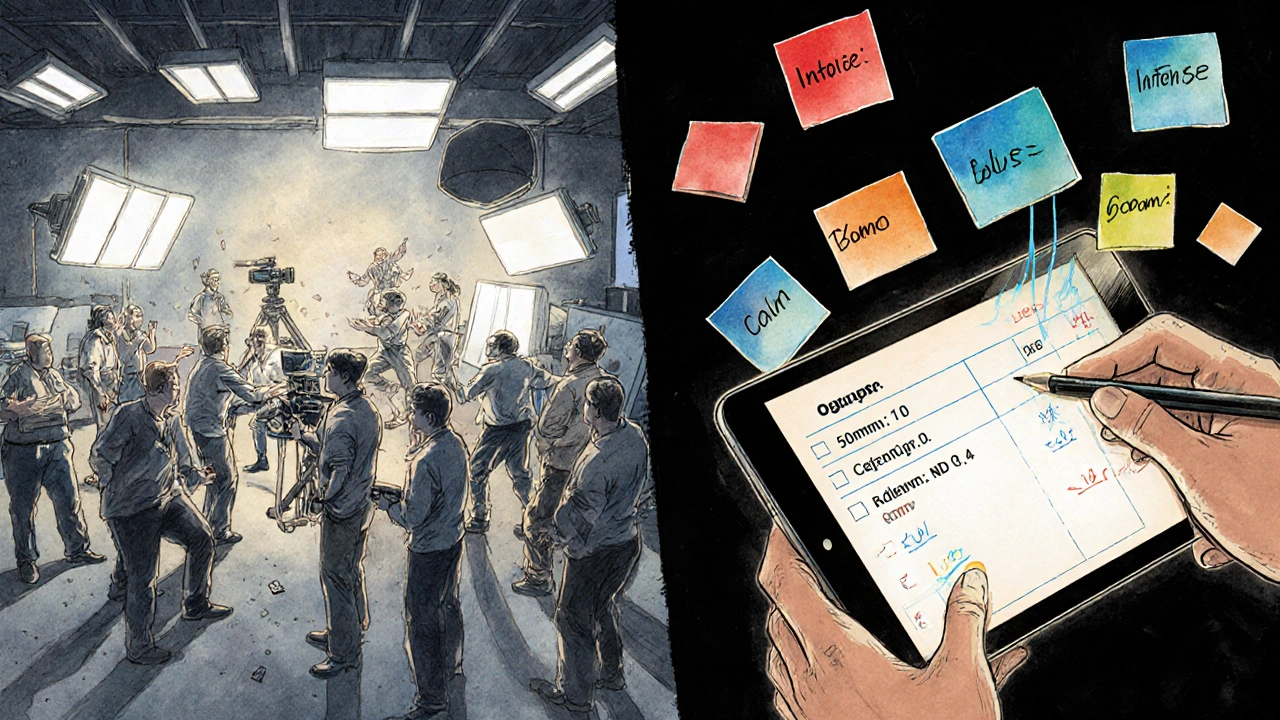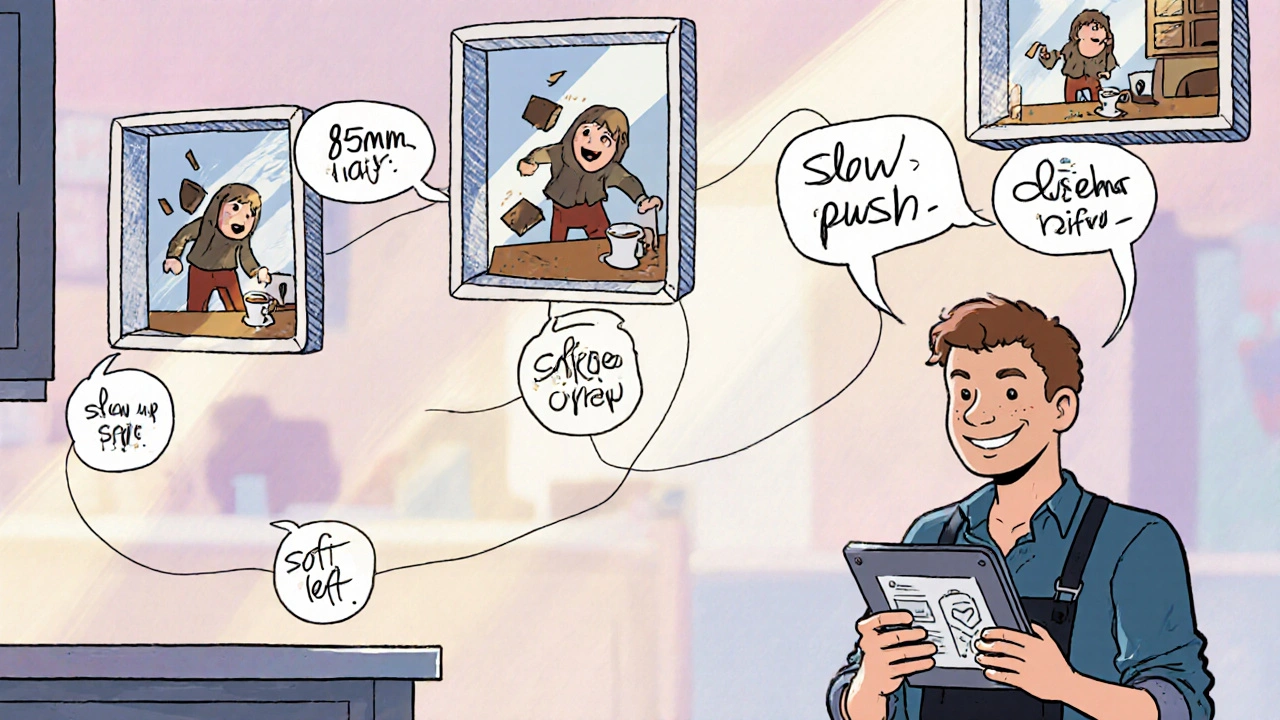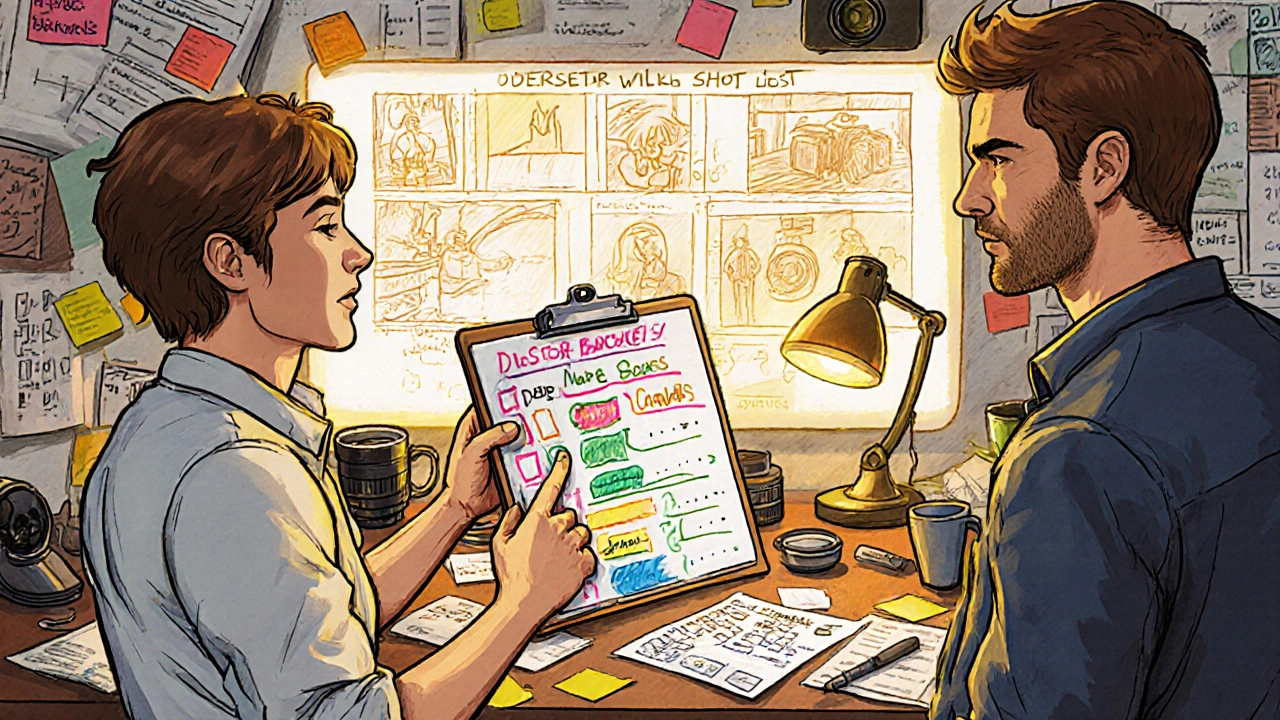Every great film starts with a plan-not just a script, but a clear map of how every frame will look. Shot listing is that map. It’s not about being rigid or robotic. It’s about making sure the vision you have in your head actually makes it to the screen-without wasting time, money, or creative energy on set.
Think of it this way: you’re directing a scene where a character walks into a room, sees something shocking, and drops their coffee. Without a shot list, you might spend 45 minutes arguing about whether to shoot the walk-in from behind, in profile, or over-the-shoulder. With a shot list? You’ve already decided. You’ve picked the lens. You’ve noted the lighting. You’ve marked the camera movement. Everyone shows up ready to shoot, not to guess.
What Exactly Is a Shot List?
A shot list is a detailed breakdown of every camera setup you need to capture your story. It’s not a storyboard. It’s not a script note. It’s a technical instruction sheet that tells your crew exactly what to do, frame by frame.
Each entry includes:
- Scene number and shot number
- Shot type (wide, medium, close-up, extreme close-up)
- Camera movement (static, dolly in, pan left, crane up)
- Camera angle (eye level, low angle, high angle, Dutch tilt)
- Lens focal length (e.g., 35mm, 85mm)
- Filter or lighting note (e.g., “ND 0.6,” “soft key from left”)
- Actor blocking or placement
- Special equipment (gimbal, crane, Steadicam)
- Frame rate or special notes (e.g., “slow motion 120fps”)
It’s not poetry. It’s precision. And it’s what separates professionals from amateurs.
Why Directors and DPs Can’t Skip This Step
Some filmmakers swear by improvisation. They say, “Let’s see what happens on set.” But here’s the hard truth: 38% more reshoots happen on productions that don’t use shot lists, according to the American Cinema Editors. That’s not just wasted time-it’s wasted money, morale, and momentum.
Directors need shot lists because they’re the storytellers. They know which moment needs to feel intimate, which needs to feel overwhelming. But they can’t be everywhere. The DPs (directors of photography) need shot lists because they’re the ones translating emotion into light and lens. Without a shared plan, you end up with mismatched coverage-close-ups that don’t match the wide, lighting that shifts between takes, continuity errors that break immersion.
Roger Deakins, one of the greatest cinematographers alive, calls shot lists “the cinematographer’s roadmap.” Nancy Schreiber, with 35 years in the business, says skipping it is “gambling with narrative clarity.” That’s not hyperbole. That’s experience.
How Shot Lists Save Time (and Money)
Let’s say you’re shooting a 10-page script. That’s roughly 10 minutes of screen time. Without a shot list, you might need 3 days to shoot it. With one? You’re done in 2.5.
StudioBinder’s 2021 survey of 247 indie sets found that productions using shot lists cut their shooting schedule by an average of 17.3%. That’s more than a full day saved on a 10-day shoot. Where does that time come from?
- No more debating lens choices on set-already decided.
- No more waiting for grip teams to set up gear you didn’t plan for.
- No more shooting coverage you won’t use because you forgot to capture the reverse angle.
Cinematographer Maria Rodriguez tracked her unit’s time savings: 22 minutes saved per scene change because lens specs were pre-determined. That adds up fast. On a 50-scene film? That’s nearly 20 hours of shooting time recovered.
And it’s not just about speed. Lighting consistency improves by 23% when shot lists are used, according to the American Society of Cinematographers. That means less time fixing exposure in post, fewer color grade headaches, and a more polished final product.
Shot List vs. Storyboard: What’s the Difference?
People mix these up all the time. Here’s the clear distinction:
- Storyboards are visual sketches. They show composition, framing, and mood. They answer: “What does this shot look like?”
- Shot lists are technical specs. They answer: “How do we shoot it?”
One is art. The other is engineering. And you need both.
72% of cinematographers surveyed by the International Cinematographers Guild use storyboards and shot lists together. The storyboard gives you the look. The shot list gives you the how.
Example: A storyboard might show a character standing in a doorway, backlit, looking sad. The shot list tells you: “Scene 12, Shot 3. Medium close-up. 50mm lens. Backlight at 45° with diffusion. Camera on dolly, slow push-in. No movement until actor turns head. Frame left eye.”
One tells the story. The other makes it possible.

Tools of the Trade: Digital Shot Listing Today
Forget paper clipboards and sticky notes. The best shot lists are digital, collaborative, and live on your phone.
Three tools dominate the market:
- StudioBinder-Used by 43% of professional crews. Integrates with scheduling, allows storyboard uploads, and has AI that suggests shot types based on your script. Its premium plan ($79/year) cuts pre-production time by 22 hours per project.
- Celtx-Great for writers and directors who want script-to-shot-list flow. Solid free tier.
- ShotPro-Built for the set. Offline mode, real-time sync, and mobile-first design. Used by 68% of DPs who shoot on location.
These tools don’t just store lists-they connect to your schedule, your lighting plan, even your camera settings. And 83% of professional productions now use cloud-based platforms for collaboration, meaning your gaffer, key grip, and assistant director can all see updates in real time.
AI is stepping in too. Adobe’s ShotAI (acquired in 2022) can auto-generate shot lists from scripts, mimicking the style of famous DPs like Roger Deakins or Emmanuel Lubezki. It’s not replacing humans-it’s accelerating them.
How to Build a Shot List (Step by Step)
Start after your script is locked. Before location scouting. Before you hire your crew.
- Read the script twice. First for story. Second for camera potential. Highlight emotional beats, transitions, and moments that need emphasis.
- Break scenes into shots. For every line of dialogue or action, ask: “What’s the best way to show this?” Start with coverage: wide, medium, close-up. Then add inserts, reaction shots, over-the-shoulder.
- Assign technical specs. Pick lenses based on mood. 24mm for tension. 85mm for intimacy. Note if you need a filter, rig, or special lighting.
- Group by location. Don’t shoot all the kitchen scenes on Day 1, then come back two weeks later. Cluster shots by set or location to save travel and setup time.
- Color-code by tone. Red = intense. Blue = calm. Yellow = hopeful. This helps your crew instantly understand the emotional intent behind each shot.
- Review with your DP. They’ll catch things you missed-like a reflection in a window, or a shadow that blocks the key light.
- Print and share. Give a copy to the 1st AD, gaffer, and key grip. Make sure everyone knows what’s coming.
Pro tip: Keep descriptions under 15 words. Too much detail slows you down. Too little leaves room for confusion.
Common Mistakes (And How to Avoid Them)
Even experienced filmmakers mess this up. Here’s what goes wrong-and how to fix it:
- Forgetting insert shots. 41% of amateur productions skip close-ups of hands, objects, or details that ground the story. Always plan for at least one insert per key moment.
- Not enough coverage. If you only shoot the actor talking, you won’t have anything to cut to during editing. Shoot reverse angles, reaction shots, and cutaways.
- Over-planning. Some shot lists have 15 shots for a 10-second scene. That’s not thorough-it’s exhausting. Trust your crew. Leave room for instinct.
- Not updating the list. Script changes? Location issues? Actor availability? Update the shot list. Keep it alive. Outdated lists cause chaos.
- Ignoring sound. Shot lists should note if a shot needs sync sound, wild lines, or if it’s silent. Don’t assume the sound team knows.
The best shot lists are flexible. They’re not prison bars-they’re guardrails.

When to Break the List
Some directors, like Richard Linklater, argue too much planning kills spontaneity. And they’re right-sometimes the best moment is unplanned.
29% of directors in a DGA survey admitted abandoning their shot list to capture actor improvisation, especially in comedy or documentary work. That’s fine. But here’s the key: you still need the list to know what you’re deviating from.
Think of it like a recipe. You follow it until the moment the smell tells you it’s ready. Then you adjust. But you didn’t start without the recipe.
On “The Revenant,” Emmanuel Lubezki used color-coded shot lists to track emotional tone. He knew exactly when to break from the plan because he had a system to measure the deviation.
What Happens Without a Shot List?
Picture this: It’s Day 4. You’re on location. The sun’s about to set. The actor just gave an incredible take. But you haven’t shot the reverse. Or the close-up. Or the insert of the letter they’re holding.
Now you have to come back tomorrow. Or pay for overtime. Or cut the scene in editing and lose its emotional punch.
That’s not bad luck. That’s poor planning.
Low-budget films suffer the most. 33% of editing problems in indie films come from insufficient coverage. That means your editor is stitching together mismatched lighting, inconsistent framing, and awkward cuts.
Shot listing doesn’t guarantee a great film. But it guarantees you won’t lose the chance to make one.
Where to Start
You don’t need a big budget to start. Film Independent offers free shot list templates used by over 12,000 filmmakers. StudioBinder has 87 tutorial videos with a 78% completion rate. Start small. Shoot a 2-minute scene. List every shot. Test it. Then do it again.
By the time you’re on your first real project, you won’t be thinking about the list. You’ll just be shooting. And that’s exactly how it should be.
Visual storytelling isn’t magic. It’s preparation. And the shot list is your most powerful tool.
What’s the difference between a shot list and a storyboard?
A storyboard shows what each shot looks like-composition, framing, mood. A shot list tells you how to shoot it-lens, movement, lighting, camera settings. Storyboards are visual; shot lists are technical. Most professionals use both together.
Do I need a shot list for a short film?
Yes-even for a 5-minute short. Short films have tighter budgets and schedules. Without a shot list, you risk running out of time, missing key moments, or ending up with unusable footage. 63% of short films use shot lists, according to the Sundance Institute.
How many shots should I plan per page of script?
For narrative features, aim for 8 to 12 shots per page. Dialogue-heavy scenes might need fewer. Action or montage scenes may need 15 or more. The goal isn’t quantity-it’s coverage. Make sure you have enough angles to edit smoothly.
Can AI replace the need for a shot list?
No. AI tools like ShotAI can generate suggestions based on your script, but they can’t replace your creative judgment. They’re assistants-not directors. The best shot lists still come from a director and DP working together, using AI to speed things up, not make decisions for them.
What if my actor wants to improvise during a shot?
That’s fine. Keep the shot list as your baseline, not your cage. If the moment feels right, shoot it. But make sure you still get the planned coverage afterward. That way, you have options in editing. Many directors shoot the scripted version first, then the improvised one.
What software should I use for shot listing?
StudioBinder is the most popular for professionals, offering integration with scheduling and storyboarding. Celtx is great for beginners and writers. ShotPro is ideal for on-set use with its mobile app and offline sync. All have free tiers to start.
Is shot listing required for union productions?
Yes. Since 2023, the Directors Guild of America requires formal shot planning documentation for all union-signatory productions with budgets over $500,000. It’s no longer optional-it’s a standard.
Next step: Grab a script. Open a blank shot list template. Pick one scene. List every shot you’d need to tell it. Don’t overthink it. Just start. The next time you’re on set, you’ll be glad you did.

